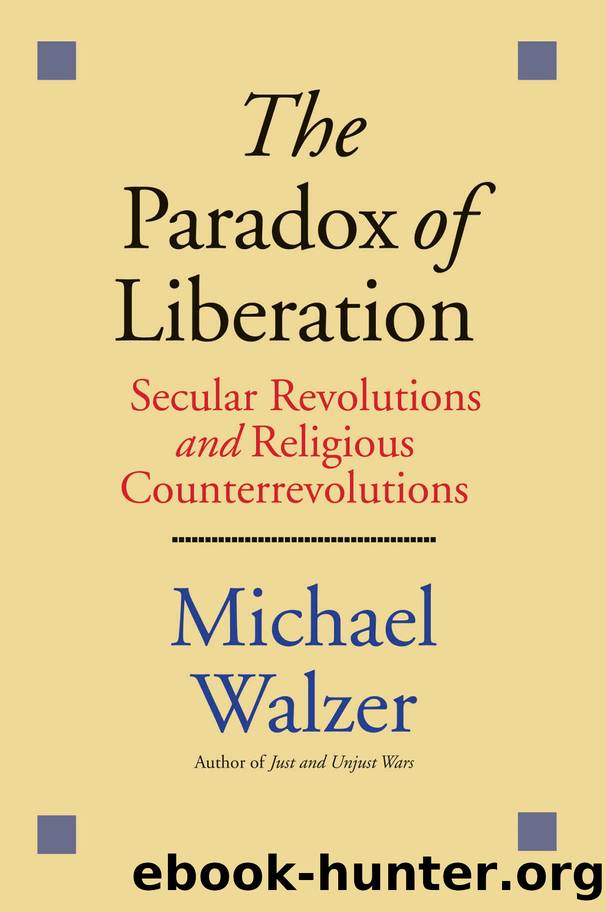The Paradox of Liberation: Secular Revolutions and Religious Counterrevolutions by Michael Walzer

Author:Michael Walzer [Walzer, Michael]
Language: eng
Format: azw3
Publisher: Yale University Press
Published: 2015-03-01T00:00:00+00:00
FOUR
The Future of National Liberation
I
If I insist on the strong opposition of secular national liberation to religious revivalism, if I deny their secret kinship and refuse to recognize the zealots as the necessary heirs of the liberators, then I must face once again the paradox of liberation and address the question it poses: Why have the leaders and militants of secular liberation not been able to consolidate their achievement and reproduce themselves in successive generations? Over the past several decades, Indian intellectuals and academics have been debating this question in its local version: âWhy is it,â one of them asks, âthat the Nehruvian vision of a secular India failed to take hold?â1 A leading figure in the recent debates is Ashis Nandy, whose work I have already cited, a longtime critic of both secular nationalism and Hindutvaâthe âdisowned doubles of each other.â In an article entitled âThe Politics of Secularism and the Recovery of Religious Toleration,â Nandy evokes a pre-modern, pluralist, and tolerant Hinduism (âfuzzyâ and syncretistic), which, he says, the militants of national liberation ignored and suppressed. Their secular and modern radicalism produced a pathological reaction, which is revivalist and also modern; the modernism is shared. Having learned from Western theories of statecraft, the partisans of liberation and the partisans of religious revival are equally willing to use the power of the modern state against their opponents.2
So Nandyâs âcritique of Hindu nationalism,â writes the philosopher Akeel Bilgrami, âis intended to be of a piece with the critique of Nehruvian secularism.â Hindutva, âitself the product of modernity, owes its very existence to the oppositional but at the same time internal dialectical relation it bears to ⦠secularism.â3 This isnât a Marxist, internationalist critique but rather an anti-modernist (or anti-Western) critique, and it has attracted wide support in India from writers, some of whom might best be identified as latter-day Gandhians; others are postmodernists and postcolonialists. Nandy argues that Gandhiâs political use of Hindu motifs was justified because his Hinduism was authenticâthat is, âlocated ⦠in traditions outside the ideological grid of modernityâ and therefore unavailable for parochial political mobilizations. By contrast, Hindutva is radically inauthentic. Nandy writes mockingly about the RSS, a paramilitary Hindu nationalist group:
Whatever the revivalist Hindu may seek to revive, it is not Hinduism. The pathetically comic martial uniform of khaki shorts, which the RSS cadres have to wear, tells it all. Modeled on the uniform of the colonial police, the khaki shorts ⦠identify the RSS as the illegitimate child of Western colonialism.
Nandy has similar things to say about the Nehruvian state, which took upon itself, he writes, the âsame civilizing mission that the colonial states had once taken upon themselves vis-Ã -vis the ancient faiths of the subcontinent.â4
That last point is certainly true; it is another example of the paradox of national liberation, but not one that necessarily carries the condemnation that Nandy intends. In 1829, for example, the British banned the satiâthe ritual immolation of a Hindu widow on her husbandâs funeral pyreâand, after independence, the new Indian government reiterated the ban, acting out, I suppose, the âsame civilizing mission.
Download
This site does not store any files on its server. We only index and link to content provided by other sites. Please contact the content providers to delete copyright contents if any and email us, we'll remove relevant links or contents immediately.
The Lost Art of Listening by Michael P. Nichols(7170)
Why I Am Not A Calvinist by Dr. Peter S. Ruckman(4051)
The Rosicrucians by Christopher McIntosh(3375)
Wicca: a guide for the solitary practitioner by Scott Cunningham(3046)
Signature in the Cell: DNA and the Evidence for Intelligent Design by Stephen C. Meyer(2880)
Real Sex by Lauren F. Winner(2874)
The Holy Spirit by Billy Graham(2782)
To Light a Sacred Flame by Silver RavenWolf(2681)
The End of Faith by Sam Harris(2637)
The Gnostic Gospels by Pagels Elaine(2403)
Waking Up by Sam Harris(2334)
Nine Parts of Desire by Geraldine Brooks(2283)
Jesus by Paul Johnson(2232)
Devil, The by Almond Philip C(2207)
The God delusion by Richard Dawkins(2193)
Heavens on Earth by Michael Shermer(2191)
Kundalini by Gopi Krishna(2094)
Chosen by God by R. C. Sproul(2058)
The Nature of Consciousness by Rupert Spira(1983)
